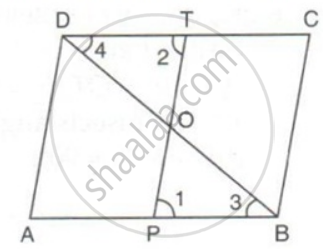Advertisements
Advertisements
Question
The medians QM and RN of ΔPQR intersect at O. Prove that: area of ΔROQ = area of quadrilateral PMON.
Solution

Join MN. Since the line segment joining the mid-points of two sides of a triangle is parallel to the third side; so, MN || QR
Clearly, ΔQMN and ΔRNM are on the same base MN and between the same parallel lines.
Therefore, area(ΔQMN) = area(ΔRNM)
⇒ Area(ΔQMN) - area(ΔONM) = area(ΔRNM) - area(ΔONM)
⇒ Area)ΔQON) = area (ΔROM) ......(i)
We know that a median of a triangle divides it into two triangles of equal areas.
Therefore, area(ΔQMR) = area(ΔPQM)
⇒ area(ΔROQ) + area(ΔROM) = area(quad, PMON) + area(ΔQON)
⇒ area(ΔROQ) + area(ΔROM) = area(quad. PMON) + area(ΔROM) ...(from (i))
⇒ area(ΔROQ) = area(quad. PMON).
APPEARS IN
RELATED QUESTIONS
ABCD is a parallelogram. P and T are points on AB and DC respectively and AP = CT. Prove that PT and BD bisect each other.
ABCD is a rectangle with ∠ADB = 55°, calculate ∠ABD.
PQRS is a parallelogram. T is the mid-point of RS and M is a point on the diagonal PR such that MR = `(1)/(4)"PR"`. TM is joined and extended to cut QR at N. Prove that QN = RN.
In a parallelogram PQRS, M and N are the midpoints of the opposite sides PQ and RS respectively. Prove that
RN and RM trisect QS.
In a parallelogram PQRS, M and N are the midpoints of the opposite sides PQ and RS respectively. Prove that
MN bisects QS.
In the given figure, PQRS is a trapezium in which PQ ‖ SR and PS = QR. Prove that: ∠PSR = ∠QRS and ∠SPQ = ∠RQP
Prove that the diagonals of a square are equal and perpendicular to each other.
Prove that the diagonals of a parallelogram divide it into four triangles of equal area.
The diagonals AC and BC of a quadrilateral ABCD intersect at O. Prove that if BO = OD, then areas of ΔABC an ΔADC area equal.
PQRS is a parallelogram and O is any point in its interior. Prove that: area(ΔPOQ) + area(ΔROS) - area(ΔQOR) + area(ΔSOP) = `(1)/(2)`area(|| gm PQRS)
